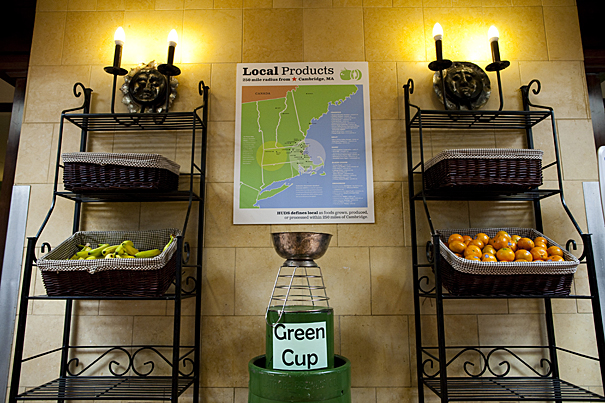
The awarding of the Green Cup was one of the highlights of the Earth Day festival at Harvard. Adams House took home the coveted trophy, which it proudly displays in the the servery of the Adams House dining hall.
Stephanie Mitchell/Harvard Staff Photographer
Harvard ends Earth Day festivities
Green Cup runneth over, won by Adams House
Harvard capped its nine-day celebration of Earth Day with a lawn festival in the shade of old trees.
On Malkin Quadrangle Saturday (April 24), experts were on hand in all things natural, from chocolate and heirloom squash to massage and planetary science.
The festival is the signature undergraduate event surrounding Earth Day every year, and is sponsored by the Harvard College Environmental Action Committee (EAC). Planning started in the fall, said event co-leader Jane Baldwin ’11, an Earth and Planetary Sciences concentrator. With her was co-leader Sachi Oshima ’13.
Some visitors carried the Harvard Earth Day Passport, a 17-item checklist of questions. Answer them all, or get a line initialed, and you could get a free Nalgene bottle. The Harvard Outing Club led off the passport session with this zinger: “How many spikes does a crampon have?” (Answer: 12.)
Passport holders had to quiz Sharon, Mass., farmer Jim Ward, the co-owner of Ward’s Berry Farm, on what three heirloom squash he sold to Harvard. (Answer: Long Island cheese squash, New England blue hubbard, and Georgia candy roaster.) Ward also showed onlookers how to cut seed potatoes for planting. And he showed off what was fresh from the farm that morning: stalks of rhubarb piled in a basket.
“The lesson is eating seasonally,” said Ward, a first-timer at the Harvard Earth Day festival. “Savor a thing when it’s in season.”
Heather Henriksen, director of Harvard’s Office for Sustainability (OFS), said 25 to 40 percent of the produce served at Harvard dining halls, in season, comes from regional producers.
Passport or not, quizzes were the language of the day. Lucien Weiss ’10 ran all-comers through the paces of a recycling race. Quick: What can be recycled? Composted? “You guys are on the inside track to victory,” he told one pair of Leverett House visitors, timing them at 27 seconds.
Weiss, a Phorzheimer House chemistry concentrator, is a “REP rep,” one of 20 House-based representatives of the Resource Efficiency Program run by OFS and the Office of Physical Resources at the Faculty of Arts and Sciences (FAS). They are peer-to-peer counselors on all issues sustainable.
When not timing racers, Weiss gave tours of a faux dorm room set out in the sunlight, a table and bookcase showcasing the right gear: an EPEAT (green-rated) computer, power strip, lamp with CFL (compact fluorescent) bulbs, and reusables such as a shopping bag, dishes, silverware, and a water bottle.
“They learn stuff,” though fun is the point too, said Henriksen, who helped out at a table demonstrating green building materials. “It captures the enthusiasm of the student groups involved.”
Quizzes, demonstrations and lessons from a local farmer all provide inspiration, said Rachel Mak ’10 of the four-hour festival. “It’s a great way to get people engaged.”
She was awarded one of Harvard’s first student sustainability grants, announced last week (April 23) by OFS. Mak designed a project for creating herb gardens in all the Houses. “We no longer have to buy herbs,” she said of the Adams House pilot this year.
As for growing things: The new Harvard Community Garden was tabling at the Earth Day festival too, inviting visitors to assemble their own sun tea mixes from fragrant sachets of mint, calendula, and other ingredients.
“This is just a preview” of what the garden itself will soon bring, said Louisa Denison ’11, one of the project’s student leaders.
Competing for nose time with the subtlety of garden mint was the aroma of grilling beef patties, courtesy of another festival first-timer, b.good, a Harvard Square restaurant mainstay.
Co-founder and owner Jon Olinto was serving up mini-burgers made from organic, hormone-free, grass-and-grain-fed beef from the Pineland Farms, a Maine-based cooperative.
“I never thought it would be possible,” said Olinto, whose six outlets now serve only regional beef. (In New England, local beef producers are scarce.) His Earth Day-style idea is to support regional farms and trim away the high environmental price of shipping food long distances.
Nearby, giving away fruit and sweet potato chips, were members of Vegitas, aka the Harvard College Vegetarian Society. Their message: A plant-based diet steps lightly on Mother Earth by using fewer resources to create healthier foods.
Along with the mix of smells, food lifestyles, and brain-squeezing quizzes, the festival offered music, including the Harvard-based band Gnome, singer-songwriter Caitria O’Neill ’11, and the Harvard College American Music Association.
But after two acts, there was time out for the festival’s highest moment of noisy drama, the awarding of the Green Cup, the annual eco-competition among Harvard Houses. Looking at the cup, a trash-like tier of recycled objects, Brandon Geller ’08 said, “I would love to have this in my room.” (He is coordinator of the undergraduate REP program.)
Besides the cup itself, the winning House got a check for $1,040. The extra $40, said Geller, is in honor of the 40th Earth Day.
He started the countdown. Third place was a tie between eco-powerhouse Mather and up-and-coming Dunster. Second place went to annual eco-tough guy Lowell. The winner was Adams House.
Tumult and shouting followed, as a joyous scrum from Adams House rushed the stage.




